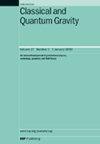相对论耗散星的扰动
IF 3.6
3区 物理与天体物理
Q2 ASTRONOMY & ASTROPHYSICS
引用次数: 0
摘要
粘性流体可以消散和改变引力波(GW)的传播,也可以改变自引力流体的弛豫和稳定特性。这对于理解中子星的弛豫平衡及其引力波发射尤为重要。在这里,我们研究了球对称自重力流体扰动的线性化理论,只处理了辐射模式。耗散效应通过贝姆菲卡、迪斯康齐、诺龙哈和科夫顿(BDNK)的流体力学理论被包括在内。尽管只涉及一阶梯度,但这一理论已被证明是因果和稳定的。我们展示了该问题如何在轴向部分简化为两个耦合波方程,其中一个方程与一种新的粘性模式相关,并包含明确的耗散项。在极区,我们将问题简化为五个耦合波方程和一个附加约束条件。我们对它们的因果结构进行了评论,并恢复了 BDNK 理论的因果性边界。本文章由计算机程序翻译,如有差异,请以英文原文为准。
Perturbations of relativistic dissipative stars
Viscous fluids can dissipate and alter the propagation of gravitational waves (GWs), as well as modify the relaxation and stability properties of self-gravitating fluids. This is particularly relevant in order to understand the relaxation to equilibrium of neutron stars, and their GW emission. Here we study the linearized theory of perturbations of spherically symmetric self-gravitating fluids, treating only the radiative modes. Dissipative effects are included through the hydrodynamics theory of Bemfica, Disconzi, Noronha and Kovtun (BDNK). This theory has been shown to be causal and stable, despite involving only first order gradients. We show how the problem reduces to two coupled wave equations in the axial sector, one of them associated to a novel viscous mode, and including explicitly dissipative terms. In the polar sector we reduce the problem to five coupled wave equations and one additional constraint. We comment on their causal structure, and recover the causality bounds of the BDNK theory.
求助全文
通过发布文献求助,成功后即可免费获取论文全文。
去求助
来源期刊

Classical and Quantum Gravity
物理-天文与天体物理
CiteScore
7.00
自引率
8.60%
发文量
301
审稿时长
2-4 weeks
期刊介绍:
Classical and Quantum Gravity is an established journal for physicists, mathematicians and cosmologists in the fields of gravitation and the theory of spacetime. The journal is now the acknowledged world leader in classical relativity and all areas of quantum gravity.
 求助内容:
求助内容: 应助结果提醒方式:
应助结果提醒方式:


